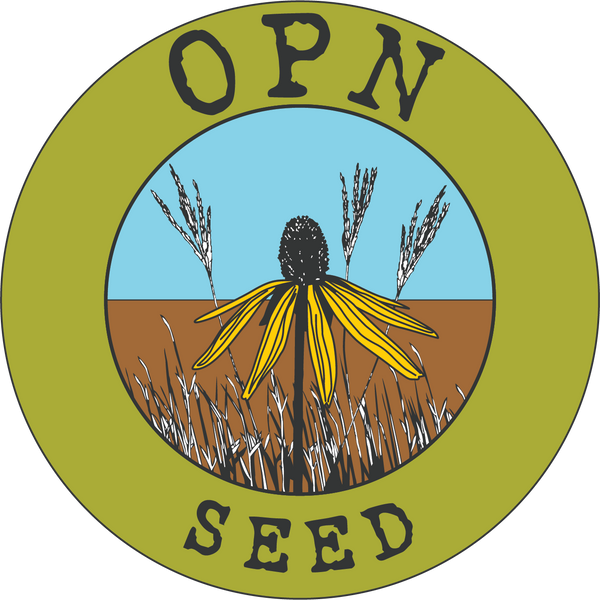Learn About Native Seed Stratification
OPN Seed (Ohio Prairie Nursery) harvests and processes the seed of many different types of species. Once the seed is processed and tested, it goes into a temperature and humidity-controlled environment for storage until it's shipped to you. Our objective is to keep the seed viable until it is ready to be planted. This can be considered a form of cold dry stratification and mimics the cool fall nights before soil moistures increase with seasonal rains.
Stratification is the process that seed goes through to break down the seed coat and allow moisture to enter the seed to begin the germination process. In nature, this occurs over time and the seed germinates when its stratification requirements have been met. Stratification times can vary in nature due to varying seasonal and weather patterns. In today's world of instant gratification, we need to understand stratification times of many different species so we can start to see results on our schedule instead of what naturally occurs.
Stratification can be understood if you observe what happens in nature. If a plant drops seed in the spring, the seed goes through summer, fall and winter and wakes up the next spring when it's time to make a new plant. This particular seed follows a natural stratification pattern of warm and dry (summer), followed by cool and moist (fall and winter). Due to varying weather patterns, stratification in nature can vary radically from year to year and increase variability with these processes.
OPN Seed (Ohio Prairie Nursery) offers recommendations for stratification of individual species that are based on research we have done using multiple seed lots in multiple trials over time. They are guidelines that will decrease the time it takes for seed to germinate. The times are useful if you are planting seed to grow plants in a controlled setting (greenhouse or containers) and will help you control the results in a predictable manner.
If you are planting your native seed directly into the earth, it is not as critical to stratify the seed. Some species appear to germinate right away while others wait longer. Seed species use this mechanism to protect themselves against natural disasters like droughts, fires, floods and other catastrophic events that would threaten the entire generation of seed.
Over the past twenty years, we have worked with countless individuals who have planted at different times of the year with good results. Please remember, when planting directly into the earth natural stratification times will vary due to sunlight, soil temperature and hydrology and weather patterns. Seeding times can vary. You can plant in the spring (an active growing season), fall (dormant seeding when soil temperatures are below 50F) or as a frost seeding when natural freeze/thaw cycles have begun. The main thing is to get the seed in the ground when you can and let nature take its course, as its been done for thousands of years.
The following stratification codes appear on our individual product pages to serve as guidelines.
CM = Cold Moist
Cold moist mimics winter. Cold moist conditions allow seed coats to soften and allow absorption of water, which is the beginning of the germination process. It has been found that different species need different lengths of time in cold moist conditions to maximize germination. The number after the CM indicates the the number of days of stratification typically required. Cold moist stratification can be accomplished by placing your seed in a refrigerator in a sealed plastic bag with a moist (not dripping wet) new clean sponge or paper towel for the required time. You can also use a sterile silica sand vermiculite as a moisture carrier. Check you seed frequently by looking at it without opening the bag. There should be no mold or fungus present.
Another easy way to mimic winter is to actually use the winter. Sow seed in trays on the north side of structure so they do not get winter sun. Cover them with screen to keep hungry critters out and let the snow pile up. As temperatures fluctuate throughout the season, the seed will stratify under actual conditions. You can also sow directly into the soil in the winter, this is called a frost seeding. This method of planting has been done by humans for generations and works very well.
CD = Cold Dry
Cold dry stratification can be accomplished by placing seed in a sealed container in a refrigerator for a period of time. Most refrigerators are high humidity and this combined with the cold temperatures are enough to enhance germination. It has been found that different species need different lengths of time in cold conditions to maximize germination.
WM = Warm Moist
Warm moist stratification mimics late summer when soil temperatures are still fairly high and late season rainfall has begun. Temperatures in the 75 to 80 degree range are sufficient for this process. Time is indicated by number following WM.
WD = Warm Dry
Warm dry stratification mimics the conditions experienced by a seed that falls into the soil in late spring. The summer soil temperatures combined with typically low rainfall combine to create this environment. It can be created either in the soil outside, or in an environmental chamber that can hold these precise temperatures over time.
